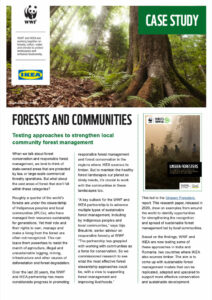Forests and communities
Testing approaches to strengthen local community forest management
When we talk about forest conservation and responsible forest management, we tend to think of state-owned areas that are protected by law or large-scale commercial forestry operations. But what about the vast areas of forest that don’t fall within these categories?
Roughly a quarter of the world’s forests are under the stewardship of Indigenous peoples and local communities (IPLCs), who have managed their resources sustainably for generations. Yet their role and their rights to own, manage and make a living from the forest are often not recognized. This can leave them powerless to resist the march of agriculture, illegal and unsustainable logging, mining, infrastructure and other causes of deforestation and forest degradation.
Over the last 20 years, the WWF and IKEA partnership has made considerable progress in promoting responsible forest management and forest conservation in the regions where IKEA sources its timber. But to maintain the healthy forest landscapes our planet so direly needs, it’s crucial to work with the communities in these landscapes too.
“A key outlook for the WWF and IKEA partnership is to advance multiple types of sustainable forest management, including by Indigenous peoples and local communities,” says Gijs Breukink, senior advisor on responsible forestry at WWF. “The partnership has grappled with working with communities as a force for conservation. So we commissioned research to see what the most effective forest stewardship approaches could be, with a view to supporting forest management and improving livelihoods.”
This led to the Unseen Foresters report. This research paper, released in 2020, drew on examples from around the world to identify opportunities for strengthening the recognition and spread of sustainable forest management led by local communities.
Based on the findings, WWF and IKEA are now testing some of these approaches in India and Romania, two countries where IKEA also sources timber. The aim is to come up with sustainable forest management models that can be replicated, adapted and upscaled to support more effective conservation and sustainable development.
For more information
Gijs Breukink
Senior Advisor Responsible Forestry WWF
gbreukink@wwf.nl
Our partnership with WWF is rooted in our ambition to deliver our IKEA Forest Positive agenda. By using our business as a springboard, we seek to generate a demonstrable positive impact to influence the wider market, for the sake of people and planet, going far beyond the needs of our own supply chain. We work together to create greater good for the environment and for communities by making responsible management a global norm – a long-stretching and inspiring journey.
– MIKHAIL TARASOV, Global Forestry Manager, IKEA
